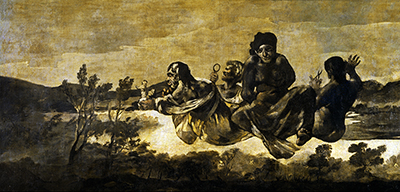Almost everyone who enjoys art from throughout the ages will have heard of Goya – to be precise: Francisco de Goya. Goya's paintings are notable for his use of light – many of his subjects seem spotlighted in otherwise dark spaces, the surroundings sometimes hinted at, but more often left amorphous and vague.
The setting, one feels, could be anywhere. But the subjects themselves sing with glorious colours, enhanced by the surrounding darkness. However, later in his life, Goya produced a series of fourteen paintings which have become known as the Black Paintings. These images are dark, with no colour, being almost greyscale and as grim in context as they are in colour scheme.
It is believed that they were painted in the last decade of his life, when the lingering after effects of an illness in his forties which left him permanently hearing impaired. The illness, now hypothesised to be an auto-immune condition, caused severe headaches and hallucinations which made Goya fearful of becoming insane. Despite living another thirty years after this illness, Goya never fully recovered, culminating in him producing these dark images in the last decade of his life as age crept up on him and his worries deepened.
This image features not only the named Atropos but her sisters too, the dread Fates (an alternative name for the image is Las Parcas or The Fates) whose job it is to spin, measure and cut the life-lines of all men. Artists throughout the ages have loved the tales of these three entities, usually depicted as women but varying from monstrous ancient hags to fair young beauties. The other two Fates are Clotho, the Spinner and Lachesis, the Measurer or Alloter. The eponymous fate of this image is known as The Inflexible for her absolute refusal to extend a life, no matter how desperately supplicants plead with her.
In the image, there is a confusion of bodies, but the three Fates are seen floating over a nondescript landscape that hints at being over water: a lake or sprawling river, perhaps? A fourth person, presumably the Fates' current victim faces out of the painting, a weary fearful resignation on his face, while his hands are drawn, and possibly tied, behind his back.
Clotho and Lachesis's faces are visible in half profile – but turned away from the man, as though their victims are so much less important than their grisly work. Atropos's face is not visible at all. Her entire focus is on her scissors, those she uses to snip the threads of lives, sending them onto to Hades and their ultimate eternal judgement.




